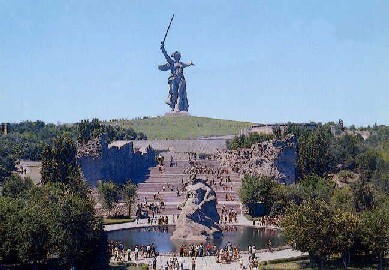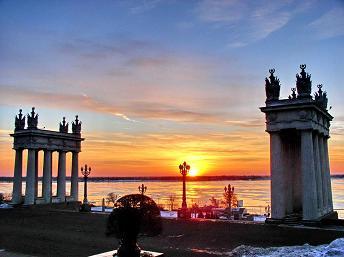City of Volgograd (Volgograd Oblast,Russian Federation)

Sister City Agreement
Established on September 28, 1972 (date of Hiroshima City Council approval)
Volgograd Facts and Figures
Who's in charge?
Mayor Vitaly Likhachev (inaugurated September 2018)
How many people live there?
Approximately 1,020,000 (as of June 2017)
How big is Volgograd?
565 km squared (approx. 0.6 times the size of Hiroshima City)
Where is it?
Volgograd sits 900 km southeast of the capital of the Russian Federation, Moscow
What's the weather like?
With a dry steppe climate, the seasonal temperature differences are extreme, averaging 27.7C in summer and -16C in winter.
Get to Know Volgograd
Located on the lower reaches of the Volga River, a large river in southeastern Russia that flows to the Caspian Sea, Volgograd is a long, narrow city which developed along the Volga River Valley. Known as Tsaritsyn until 1925, and then as Stalingrad until 1961, the City of Volgograd began as a fortress on the Volga River in 1589. Taking advantage of its river ports and capability for water transportation, the city developed into an industrial hub in the second half of the 19th century. After the Russian Revolution in 1917, the city became a leading commercial and cultural center in Russia.
During WWII, 85% of the buildings in the city were destroyed in the Battle of Stalingrad from July 1942 to February 1943. The war also took a heavy toll on the population, dropping from over 1.5 million to a mere 32,000.
After the end of WWII, Volgograd wasted no time in rebuilding, taking its place as one of Russia's leading cities. With flourishing steel, machinery, and timber processing industries, Volgograd is also a center for culture and the arts with numerous theater troupes, symphony orchestras, and circuses, as well as art museums, theatre houses, and more.
A Little History About Our Sister City Agreement
In August 1961, Stalingrad (current Volgograd) sent a telegram to the City of Hiroshima, writing of their intentions to establish a sister city relationship with Hiroshima. This initiative was proposed and advocated by the Soviet government, who also pushed for sister city agreements between Tokyo and Moscow, and Osaka and Leningrad (current St. Petersburg). The telegram became a catalyst, and from then on, both cities began exchange initiatives on the administrative and cultural level, cultivating a friendly relationship to one another.
It was on May 18, 1968, during a Hiroshima goodwill delegation visit to Volgograd that both mayors signed the sister city agreement stating, "In view of the reality of the historically unprecedented destruction that our two cities have suffered at the hands of weapons, both atomic and not, it is necessary of our cities to combine our efforts in striving for the realization of world peace." The agreement specifies that the sister city agreement is "built upon the foundation of propelling mutual understanding, respect, and friendship."
However, due to changes in international circumstances, approval of the agreement by the Hiroshima City Council was temporarily postponed until September 28, 1972 when the Chairperson of the Volgograd City Executive Committee (equivalent of mayor) visited Hiroshima City as head of a goodwill delegation. It was then that the agreement was formally approved by the Hiroshima City Council and their relationship made official.
Building Bridges Through Exchange

From citizen delegations from Russo-Japanese exchange groups to promote friendship, to mutual visits by government officials and city council members, the two cities have carried out a wide variety of exchange initiatives since becoming official sister cities. Exchanges on the cultural level have taken place through folk dance groups, co-ops, an artwork exchange between elementary schoolers, goodwill citizen delegation dispatch, and more, as well as economic exchanges through market economy seminars in Volgograd to hosting training groups studying market economics.
The City of Volgograd is a passionate advocate for peace, serving as a Lead City for Mayors for Peace (formerly the World Conference for Mayors for Peace through Intercity Solidarity), an organization headed by Hiroshima City and Nagasaki City, and holding a Peace Memorial Ceremony in solidarity every year on August 6. On the 40th anniversary of our sisterhood in 2012, a Hiroshima City delegation including Mayor Kazumi Matsui paid visit to Volgograd for a commemorative ceremony where both cities reaffirmed their commitment to continued cooperation to inspire further mutual understanding, respect, and friendship.
To coincide with the Mayor's visit, the City of Volgograd held the Hiroshima and Nagasaki Poster Exhibition, delivering a message of nuclear non-proliferation and lasting world peace to the people of Volgograd.
In November of the same year, former Mayor Valeriy Vasilkov led a delegation to visit Hiroshima for Volgograd Day, a celebration held as part of the commemorative events held in Hiroshima to mark the 40th anniversary.
Inquiries regarding this page
Internationalization Division, Citizens Affairs Bureau
1-6-34 Kokutaiji-machi, Naka-ku, Hiroshima
Phone: +81 82-504-2106 / Fax: +81 82-249-6460
Mail: [email protected]
